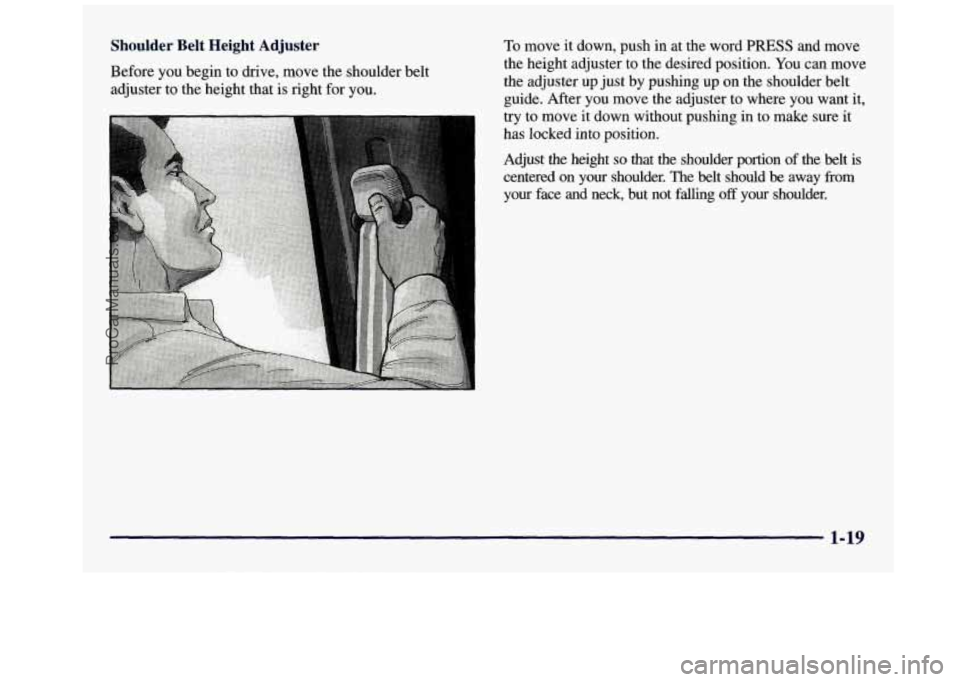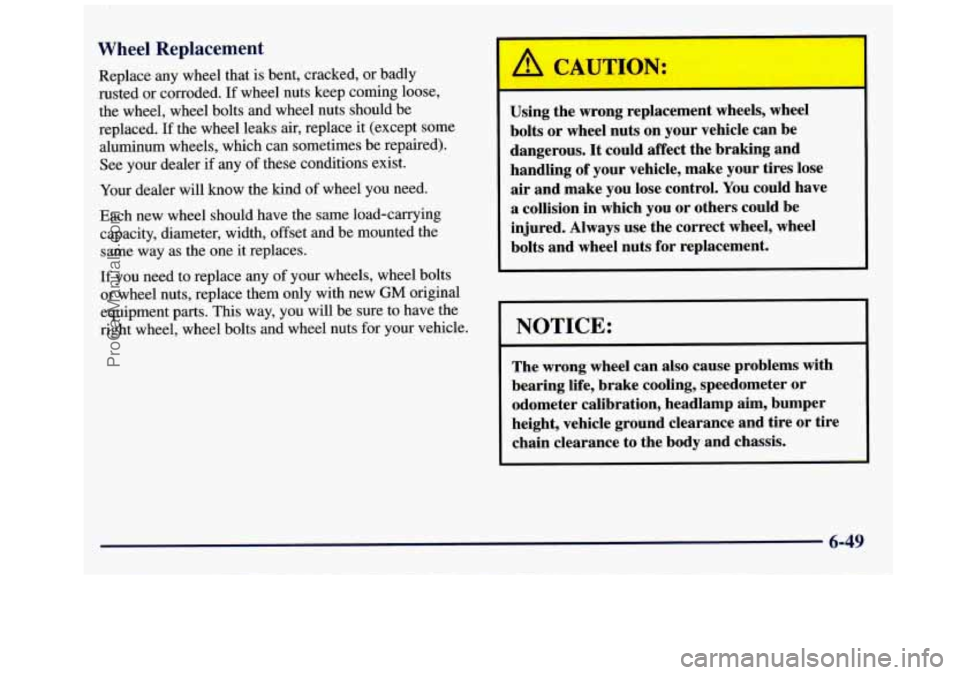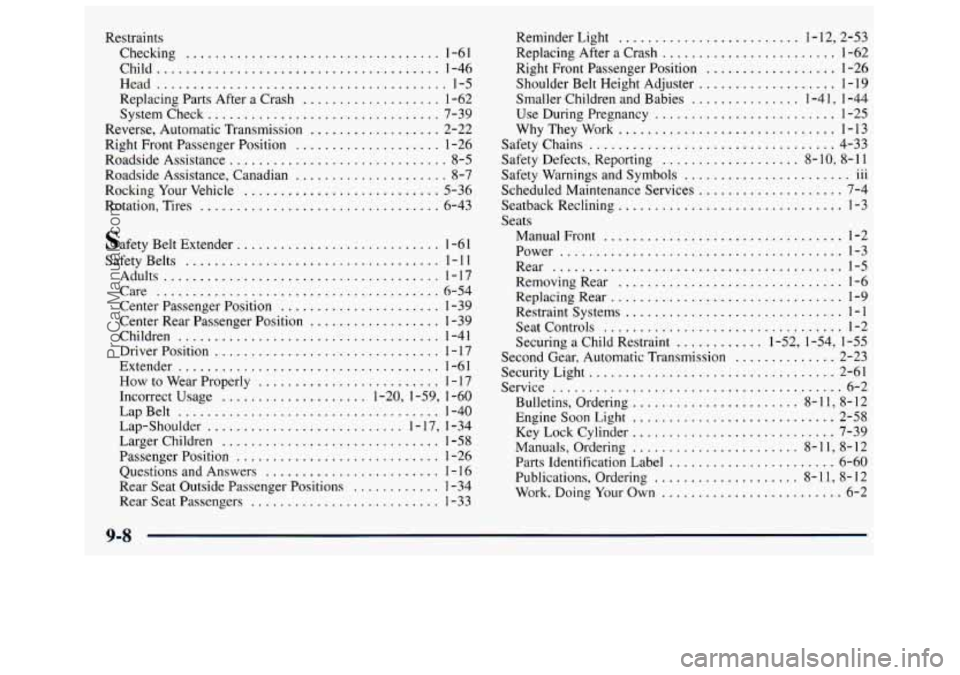1998 GMC SAVANA height
[x] Cancel search: heightPage 27 of 388

Shoulder Belt Height Adjuster
Before you begin to drive, move the shoulder belt
adjuster to the height that is right for you.
To move it down, push in at the word PRESS and move
the height adjuster to the desired position. You can move
the adjuster up just by pushing up on the shoulder belt
guide. After you move the adjuster to where you want it,
try to move it down without pushing in to make sure it
has locked into position.
Adjust the height
so that the shoulder portion of the belt is
centered on your shoulder. The belt should be away
from
your face and neck, but not falling off your shoulder.
1-19
ProCarManuals.com
Page 41 of 388

Adding Equipment to Your Air
Bag-Equipped Vehicle
e.’ If I add a push bumper or a bicycle rack to the
front of
my vehicle, will it keep the air bags
from working properly?
A: As long as the push bumper or bicycle rack is
attached to your vehicle
so that the vehicle’s basic
structure isn’t changed, it’s not likely to keep the
air bags from working properly in
a crash.
Is there anything I might add to the front of the
vehicle that could keep the air bags from
working properly?
A: Yes. If you add things that change your vehicle’s
frame, bumper system, front end sheet metal or
height, they may keep
the air bag system from
working properly. Also, the air bag system may not
work properly if you relocate any of the air bag
sensors.
If you have any questions about this, you
should contact Customer Assistance before you
modify your vehicle. (The phone numbers
and
addresses for Customer Assistance are in Step Two
of the Customer Satisfaction Procedure in this
manual. See “Customer Satisfaction Procedure”
in the Index.)
1-33
ProCarManuals.com
Page 56 of 388

, . ..
A forward-facing child restraint (C-E) positions a
child upright to face forward in the vehicle. These
forward-facing restraints are designed to help protect
children
who are from 20 to 40 lbs. (9 to 18 kg) and
about
26 to 40 inches (66 to 102 cm) in height, or up
to around four years of age. One type, a convertible
restraint,
is designed to be used either as a rear-facing
infant seat or a forward-facing child seat.
1-48
ProCarManuals.com
Page 270 of 388

Brake Wear
Your vehicle has front disc brakes and rear drum brakes.
Disc brake pads have built-in wear indicators
that
make a high-pitched warning sound when the brake
pads are worn and new pads are needed. The sound
may come and go or be heard all the time your vehicle
is moving (except when you are pushing on the brake
pedal firmly).
The brake wear warning sound means that soon
your brakes won’t work well. That could lead to
an accident. When you hear the brake wear
warning sound, have your vehicle serviced.
I NOTICE:
Continuing to drive with worn-out brake pads
could result in costly brake repair.
Some driving conditions or climates may cause a
brake squeal when the brakes are first applied or
lightly applied. This does not mean something is
wrong with your brakes.
Properly torqued wheel nuts
are necessary to help
prevent brake pulsation. When tires are rotated, inspect
brake pads for wear and evenly torque wheel nuts in
the proper sequence
to GM specifications.
Your rear drum brakes don’t have wear indicators, but
if you ever hear a rear brake rubbing noise, have the
rear brake linings inspected immediately.
Also, the rear
brake drums should be removed and inspected each time
the tires are removed for rotation or changing. When
you have the front brake pads replaced, have the rear
brakes inspected, too.
Brake linings should always
be replaced as complete
axle sets.
See “Brake System Inspection” in Section
7 of this
manual under Part
C “Periodic Maintenance Inspections.”
Brake Pedal Travel
See your dealer if the brake pedal does not return to
normal height, or if there
is a rapid increase in pedal
travel. This could be a sign of brake trouble.
6-30
ProCarManuals.com
Page 289 of 388

Wheel Replacement
Replace any wheel that is bent, cracked, or badly
rusted or corroded. If wheel nuts keep coming loose,
the wheel, wheel bolts and wheel nuts should be
replaced.
If the wheel leaks air, replace it (except some
aluminum wheels, which can sometimes be repaired).
See your dealer if any
of these conditions exist.
Your dealer will know the kind of wheel you need.
Each new wheel should have the same load-carrying
capacity, diameter, width, offset and be mounted the
same way as the one it replaces.
If you need to replace any of your wheels, wheel bolts
or wheel nuts, replace them only with new
GM original
equipment parts.
This way, you will be sure to have the
right wheel, wheel bolts and wheel nuts for your vehicle.
Using the wrong replacement wheels, wheel
bolts or wheel nuts
on your vehicle can be
dangerous. It could affect the braking and
handling
of your vehicle, make your tires lose
air and make you lose control. You could have
a collision in which you or others could be
injured. Always use the correct wheel, wheel
bolts and wheel nuts for replacement.
NOTICE:
The wrong wheel can also cause problems with
bearing life, brake cooling, speedometer or
odometer calibration, headlamp aim, bumper
height, vehicle ground clearance and tire or tire
chain clearance to the body and chassis.
6-49
ProCarManuals.com
Page 382 of 388

Restraints Checking
................................... 1-61
Child ....................................... 1-46
Head
........................................ 1-5
Replacing Parts After a Crash
................... 1-62
System Check
................................ 7-39
Reverse, Automatic Transmission
.................. 2-22
Right Front Passenger Position
.................... 1-26
Roadside Assistance
.............................. 8-5
Roadside Assistance. Canadian
..................... 8-7
Rocking Your Vehicle
........................... 5-36
Rotation, Tires
................................. 6-43
Safety Belt Extender
............................ 1-61
Safety Belts
................................... 1 . 1 I
Adults ...................................... 1-17
Care
....................................... 6-54
Center Passenger Position
...................... 1-39
Center Rear Passenger Position
.................. 1-39
Children
.................................... 1-41
Driver Position
............................... 1 . 17
Extender
.................................... 1-61
How
to Wear Properly ......................... 1 - 17
Incorrect Usage
.................... 1-20, 1-59, 1-60
LapBelt
.................................... 1-40
Lap-Shoulder
........................... 1-17, 1-34
Larger Children
.............................. 1-58
Questions and Answers
........................ 1 - 16
Rear Seat Passengers
.......................... 1-33
Passenger
Position
............................ 1-26
Rear Seat Outside Passenger Positions
............ 1-34 Reminder
Light
......................... I . 12. 2.53
Replacing After a Crash ........................ 1-62
Right Front Passenger Position
.................. 1-26
Shoulder Belt Height Adjuster
................... 1 . 19
Smaller Children and Babies
............... 1.41. 1-44
Use During Pregnancy
......................... 1-25
WhyTheyWork
.............................. 1-13
Safety Chains .................................. 4-33
Safety Defects. Reporting ................... 8- 10. 8- 11
Safety Warnings and Symbols ....................... 111
Scheduled Maintenance Services .................... 7-4
Seatback Reclining ............................... 1-3
Seats ManualFront
................................. 1-2
Power
....................................... 1-3
Rear
........................................ 1-5
Removing Rear
............................... 1-6
Replacing Rear
................................ 1-9
Restraint Systems
.............................. 1-1
Seatcontrols ................................. 1-2
Securing
a Child Restraint ............ 1-52. 1-54. 1-55
Second Gear. Automatic Transmission
.............. 2-23
Security Light
.................................. 2-61
Service
........................................ 6-2
Bulletins. Ordering
....................... 8-1 1. 8-12
Key Lock Cylinder
............................ 7-39
Parts Identification Label
....................... 6-60
Publications. Ordering
.................... 8- 11. 8- 12
Work. Doing Your Own
......................... 6-2
...
Engine Soon Light ............................ 2-58
Manuals. Ordering
....................... 8- 1 1. 8- 12
9-8
ProCarManuals.com
Page 383 of 388

Service and Appearance Care ...................... 6-1
Service and Owner Publications
.............. 8- 1 1. 8. 12
Service Publications
........................ 8- 1 1. 8. 12
Servicing Your
Air Bag-Equipped Vehicle ........... 1-32
Sheet Metal Damage
............................ 6-57
ShiftLever
............................... 2.21. 2.25
Shifting
Automatic Transmission
....................... 2-2 1
Into . Park (P) ................................. 2-25
OutofPark
.................................. 2-28
Sidemarker Lamp Bulb Replacement
............... 6-36
SignalingTurns
................................ 2-35
Skidding
...................................... 4-13
Specifications and Capacities
...................... 6-67
Speech Impaired. Customer Assistance
............... 8-4
Speedometer
................................... 2-52
Stains. Cleaning
................................ 6-52
Starter Switch Check
............................ 7-40
Starting Your Engine
............................ 2- 18
Steam ........................................ 5-12
Steering
....................................... 4-8
In Emergencies
............................... 4- 10
Power ....................................... 4-8
Speedsensitive
............................... 4-9
Tips
......................................... 4-9
Wheel. Tilt
.................................. 2-34
StorageAreas
.................................. 2-48
Storage. Vehicle
................................ 6-3 1
Stuck: In Sand. Mud. Ice or Snow .................. 5-36
Sunvisors
.................................... 2-49
Symbols. Vehicle
.................................. v
Shoulder Belt Height Adjuster ..................... 1 . 19 Taillamp
Bulb Replacement
...................... 6-37
TapePlayerCare
............................... 3-25
Temperature Control. Rear Passenger
................ 3-5
Theft
......................................... 2-15
Theft-Deterrent Feature
.......................... 3-21
Thermostat
.................................... 6-25
Third Gear. Automatic Transmission
................ 2-23
Tilt Steering Wheel
............................. 2-34
Time. Setting the
................................ 3-7
Tire Chains
.................................... 6-50
TireLoading ................................... 4-27
Tire-Loading Information Label
................... 4-27
Tires
......................................... 6-41
Alignment and Balance
........................ 6-48
BuymgNew
................................. 6-46
Chains
..................................... 6-50
Changing
a Flat .............................. 5-22
Cleaning
.................................... 6-57
Dual Operation
............................... 6-45
Inflation
.................................... 6-42
Inflation Check
............................... 7-38
Inspection and Rotation
........................ 6-43
Loading
.................................... 4-27
Pressure
.................................... 6-42
Temperature
................................. 6-48
Traction
.................................... 6-48
Treadwear
................................... 6-47
Uniform Quality Grading
....................... 6-47
Wear Indicators
.............................. 6-45
Wheel Replacement
........................... 6-49
When It’s Time for New
....................... 6-45
TopStrap ..................................... 1-51
9-9
ProCarManuals.com